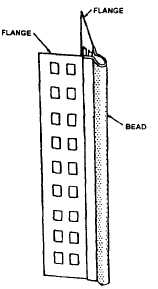Metal Lath
All metal lath is installed with the sides and ends
lapped over each other. The laps between supports
should be securely tied, using 18-gauge tie wire. In
general, metal lath is applied with the long length at right
angles to the supports. Rib lath is placed with the ribs
against the supports and the ribs nested where the lath
overlaps. Generally, metal lath and wire lath are lapped
at least 1 inch at the ends and 1/2 inch at the sides. Some
wire lath manufacturers specify up to 4 1/2-inch end
lapping and 2-inch side laps. This is done to mesh the
wires and the paper backing.
Lath is either nailed, stapled, or hog-tied (heavy
wire ring installed with a special gun) to the supports at
6-inch intervals. Use 1 1/2-inch barbed roofing nails
with 7/16-inch heads or 1 inch 4-gauge staples for the
flat lath on wood supports. For ribbed lath, heavy wire
lath, and sheet lath, nails or staples must penetrate the
wood 1 3/8 inches for horizontal application and at least
3/4 inch for vertical application. When common nails
are used, they must be bent across at least three lath
strands.
On channel iron supports, the lath is tied with No.
18-gauge tie wire at 4-inch intervals using lathers’
nippers. For wire lath, the hog tie gun can be used. Lath
must be stretched tight as it is applied so that no sags or
buckles occur. Start tying or nailing at the center of the
sheet and work toward the ends. Rib lath should have
ties looped around each rib at all supports, as the main
supporting power for rib lath is the rib.
When you install metal laths at both inside and
outside corners, bend the lath to forma comer and carry
it at least 4 inches in or around the corner. This provides
the proper reinforcement for the angle or comer.
Lath Accessories
A wide variety of metal accessories is produced for
use with gypsum and metal lathing. Lathing accessories
are usually installed before plastering to form true
corners, act as screeds for the plasterer, reinforce
possible weak points, provide control joints, and
provide structural support.
Lathing accessories consist of structural com-
ponents and miscellaneous accessories. The principal
use of structural components is in the construction of
hollow partitions. A hollow partition is one containing
no building framing members, such as studs and plates.
Structural components are lathing accessories that take
the place of the missing framing members supporting
Figure 7-6.—Perforated flanged corner bead.
the lath. These include prefabricated metal studs and
floor and ceiling runner tracks. The runner tracks take
the place of missing stud top and bottom plates. They
usually consist of metal channels. Channels are also
used for furring and bracing.
Miscellaneous accessories consist of components
attached to the lath at various locations. They serve to
define and reinforce comers, provide dividing strips
between plaster and the edges of baseboard or other
trim, and define plaster edges at unframed openings.
Comer beads fit over gypsum lath outside corners
to provide a true, reinforced comer. They are available
in either small-nose or bullnose types, with flanges of
either solid or perforated (fig. 7-6) metal. They are
available with expanded metal flanges.
Casing beads are similar to comer beads and are
used both as finish casings around openings in plaster
walls and as screeds to obtain true surfaces around doors
and windows. They are also used as stops between a
plaster surface and another material, such as masonry or
wood paneling. Casing beads are available as square
sections, modified-square sections, and quarter-rounds.
Base or parting screeds are used to separate plaster
from other flush surfaces, such as concrete. Ventilating
expansion screed is used on the underside of closed
soffits and in protected vertical surfaces for ventilation
of enclosed attic spaces. Drip screeds act as terminators
of exterior portland cement plaster at concrete
foundation walls. They are also used on external
horizontal comers of plaster soffits to prevent drip stains
7-7

